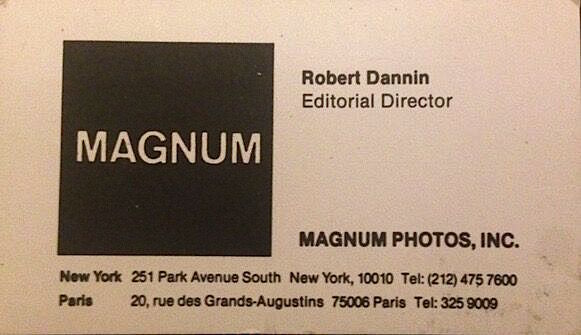 [Editor’s Note: Here we continue “The Dannin Papers,” a series of Guest Posts by Robert Dannin, who served as Editorial Director of Magnum Photos from 1985-90.
[Editor’s Note: Here we continue “The Dannin Papers,” a series of Guest Posts by Robert Dannin, who served as Editorial Director of Magnum Photos from 1985-90.
This second chapter — Dannin’s first-hand observations of the evolution and impact on the profession of the “A Day in the Life of …” book series (DITLO) as conceived and masterminded by Rick Smolan — appears in seven installments, of which this is the second. Click here for Part 1; click here for Part 3. — A. D. C.]
•
The Assassination of Photography:
The Plot to Hack Reality (b)
by Robert Dannin
… By early 1986 I had been Magnum’s editorial director for almost a year when Rick Smolan and his co-conspirator David Cohen, a former employee at Contact Press Images, began inviting photographers to participate in the Day in the Life of America book project. It was going to be their biggest effort yet, covering the entire country with an expanded team of photographers, plus more editors, and sponsorship by the Fortune 500 companies: Eastman Kodak, Nikon, Northwest Airlines, Bank of America, Merrill Lynch, United Airlines, Pan American Airways, Apple, and Hertz.
Their pitch began with a statement dripping with the bogus triumphalism of the Reagan era:
“We want to do this book because we sense that something is changing in America. This change has come very slowly and quietly. You can hear it in the songs and on the radio and you can see it printed on t-shirts. For the first time in years there seems to be a real pride in being American. This country has changed a great deal in the last decade and, like many people, we are curious about exactly what has happened to change the mood of the nation so dramatically.”
Top-forty and t-shirts? Were they talking about the same stuff I was hearing, the year’s top Billboard hit, “That’s What Friends Are For” by Dionne Warwick with Gladys Knight, Elton John & Stevie Wonder? Or maybe Whitney Houston’s “Greatest Love of All”? Madonna’s “Papa Don’t Preach” suggested change was no doubt in the air, but only because pop music was morphing into five-minute video clips emphasizing visual imagery over the tinny sound of television speakers.
Assignments based on t-shirt slogans and swag sounded like a new method for conjuring stories; I’d never hear of it before. Why bury one’s head in print if this was the new journalism?
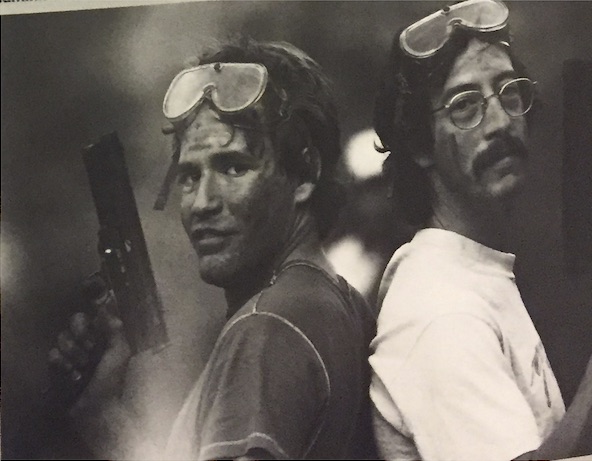
Triggermen: David Cohen (l) and Rick Smolan (r) at an unidentified paintball park. Photographer unknown.
They promised a different kind of book, too:
“In the past, many photographers and publishers have set out to produce books about life in America but they have usually concentrated on American scenery or showed America from a tourist’s point of view. With your help, we have a unique opportunity to discover the real day-to-day life of the American people.”
Was this a joke? An exaggerated critique of Ansel Adams and Robert Frank? At Magnum around then, Eugene Richards was working on a series of assignments that would lead to the publication of Below the Line: Living Poor in America (1987). Bruce Davidson’s Subway, a gritty depiction of the daily commute in New York City, was already in production (Aperture, 1986). We were gearing up for a Magnum group project on homelessness, and had recently syndicated Nick Nichols’s “Tacky Tourist Attractions,” a sharp, humorous look at roadside architecture that antedated the insufferable slapstick of Martin Parr. Why denigrate a century of American photography that included books by Dorothea Lange and Walker Evans?
With great hubris, they were going to reinvent photojournalism. The first tactic of this radical makeover: Ignore conventional reportage by dispersing photographers to randomly selected venues and encouraging them to burn as much film as possible in a 24-hour period.
The American DITLO event itself would become “historic,” the pictures serving as testimony to having witnessed and participated in it. The editors selected images from the stories and locations shot by each photographer. This process yielded the pictures chosen for the book, some outtakes, and a larger cache of generic stock images to satisfy the corporate sponsors’ advertising needs. (Presumably, any photographs not selected for one of those tiers got returned to the photographers.)
Everything was consigned to Woodfin Camp Associates, the New York stock agency that also syndicated Contact Press photographers. Dupes of the book-selects and generic images were also distributed to a network of seven foreign agents to promote the book and fulfill their own stock requests.
Although the specific terms varied with each DITLO project, the sponsors and agents had free/no-fee access to the selects for three years and the rest of the material for a period of no less than five years. The contracts were never transparent about reporting or payments resulting from licensing by the agents. The revenues from stock sales, if any, went to the agents and Collins, the publisher. (Afterwards the pictures and rights supposedly reverted to the photographers.)
The book therefore served a dual purpose: as an object memorializing an event devoid of any real significance, and as a reference catalog for stock picture sales. By signing a Day in the Life contract, photographers surrendered not only the rights to their own pictures but also the right to representation of their own choosing.
The offer read as if it had been ripped from a television game show:
“All expenses including air and ground travel will be covered by us. In return for one day of shooting you have the choice of receiving either a cash honorarium or an Apple 512K enhanced Macintosh computer system and Imagewriter 11 printer. Nikon cameras will also supply each photographer with one of their new Action-Touch 35mm cameras. In addition, you will receive a Banana Republic photojournalist’s vest designed by the renowned photojournalist Dr. Matthew Naythons.”
•
Smolan’s and Cohen’s second tactic for this reconfiguration of the industry: Blur the distinction between professional and amateur photographers, thereby disrupting the hierarchy characteristic of photojournalism as a craft. By assembling working magazine and newspaper photographers together with stringers, freelancers, apprentices, students, and ubiquitous non-professional camera owners, the conspirators were shilling for the project’s leading sponsors, Kodak and Nikon, whose principal sources of profit lay in inducing amateurs to spend like professionals on film, processing, expensive lenses, and accessories. (The very notion of a scout-like jamboree used to promote the event also served to undermine standards of compensation and copyright.)
Another function of this exercise was as a giant meet-up to introduce the participating editors to dozens of new faces whom they might call upon for spot assignments, thereby economizing on travel expenses and day rates for the pros. To put this into perspective, one could describe the project as an exercise meant to create a reserve army of photographers, all the better to reduce wages and increase profits.
•
The exploitation inherent to this process would have been more obvious if not for accomplices who, consciously or not, sanctioned these disruptions. In the relatively small world of photojournalism, everyone needs to cement relationships with editors. Traditionally, this was an organic process, beginning with the portfolio review, when a freelancer wrangled an appointment to show her stuff to a magazine editor. One worked one’s way up the ladder through persistence, submitting good pictures on spec, maintaining and growing one’s list of contacts, and always, always, pitching new story ideas.
It was the standard rite of passage for entering the trade, one that I learned to recite whenever a young photographer came looking for representation. “You don’t need an agency until the agent comes looking for you,” I would explain, after asking which magazines and editors had already seen the portfolio and offered assignments. Breaking with this practice, Day in the Life recruited editors from multiple publications and tasked them with the job of assigning and editing pictures by photographers whose work was often unfamiliar, and sometimes far below the acceptable standards for their own publications.
•
The editorial superstructure of the DITLO projects comprised the industry’s notables. John Durniak, formerly a picture editor at the New York Times and Time Magazine, had worked as a consulting editor on the previous Day in the Life projects. Arnold Drapkin, his successor at Time, and Dieter Steiner, the U.S. picture editor for the German magazine Stern, were both mid-career photography editors who cycled pictures up the production line from their researchers to the writers and art departments of their respective magazines. Karen Mullarkey, who had replaced the formidable Jim Kenney at the helm of the Newsweek photo department, and the irrepressible Susan Vermazen of New York magazine were joined by Michael Rand, photo editor of London’s Sunday Times Magazine, and two editors from Paris — Claudine Maugendre of Actuel and Christian Caujolle of Libération.
 Leading the team was Rich Clarkson, a sports photographer, former president of the National Press Photographers Association and current director of photography at National Geographic Magazine. Excepting Durniak, who worked for Collins, this project’s publisher, they represented major picture-consuming magazines and thus could never have participated without the assent of the companies’ top brass.
Leading the team was Rich Clarkson, a sports photographer, former president of the National Press Photographers Association and current director of photography at National Geographic Magazine. Excepting Durniak, who worked for Collins, this project’s publisher, they represented major picture-consuming magazines and thus could never have participated without the assent of the companies’ top brass.
Smolan and Cohen secured Clarkson’s cooperation by anchoring the project in Denver, his home away from Washington. Adding the National Geographic imprimatur enhanced the project’s legitimacy among the sponsoring companies and photographers. This play came directly from a Marketing 101 course in cross-branding: to multiply favorable perceptions of a given product through prestigious associations, serving to reinforce the impression of quality.
 Joining them were the agents, led by Robert Pledge of Contact Press Images, Woodfin “Woody” Camp of the eponymous stock agency, Eliane Laffont of Sygma, Howard Chapnick of Black Star, and Shirley LeGoubin of Colorific in London. Pledge and Laffont had worked on the previous shoots, beginning in Australia, and were integral members of the Day in the Life enterprise. Representing the French side of the industry, they assisted in the selection of photographers, choosing those deemed reliable, cooperative, and congenial. (Returning from Day in the Life of Hawaii in 1984, Eliane was very taken with one photographer. “I like her. She knows how to have fun!” It was one of the more obvious criteria for selecting photographers.)
Joining them were the agents, led by Robert Pledge of Contact Press Images, Woodfin “Woody” Camp of the eponymous stock agency, Eliane Laffont of Sygma, Howard Chapnick of Black Star, and Shirley LeGoubin of Colorific in London. Pledge and Laffont had worked on the previous shoots, beginning in Australia, and were integral members of the Day in the Life enterprise. Representing the French side of the industry, they assisted in the selection of photographers, choosing those deemed reliable, cooperative, and congenial. (Returning from Day in the Life of Hawaii in 1984, Eliane was very taken with one photographer. “I like her. She knows how to have fun!” It was one of the more obvious criteria for selecting photographers.)
 As charter members of the enterprise, Laffont and Pledge were invested in its success, although it was difficult to understand how they would benefit directly. If there was little professional advantage to be gained by undermining their own business, A Day in the Life of America appealed nonetheless to their colossal narcissism and thus facilitated Smolan and Cohen’s task of corralling 200 photographers. Finally, the otherwise respectable Howard Chapnick got sucked into the carnival because — my guess only — he did not want to be left out.
As charter members of the enterprise, Laffont and Pledge were invested in its success, although it was difficult to understand how they would benefit directly. If there was little professional advantage to be gained by undermining their own business, A Day in the Life of America appealed nonetheless to their colossal narcissism and thus facilitated Smolan and Cohen’s task of corralling 200 photographers. Finally, the otherwise respectable Howard Chapnick got sucked into the carnival because — my guess only — he did not want to be left out.
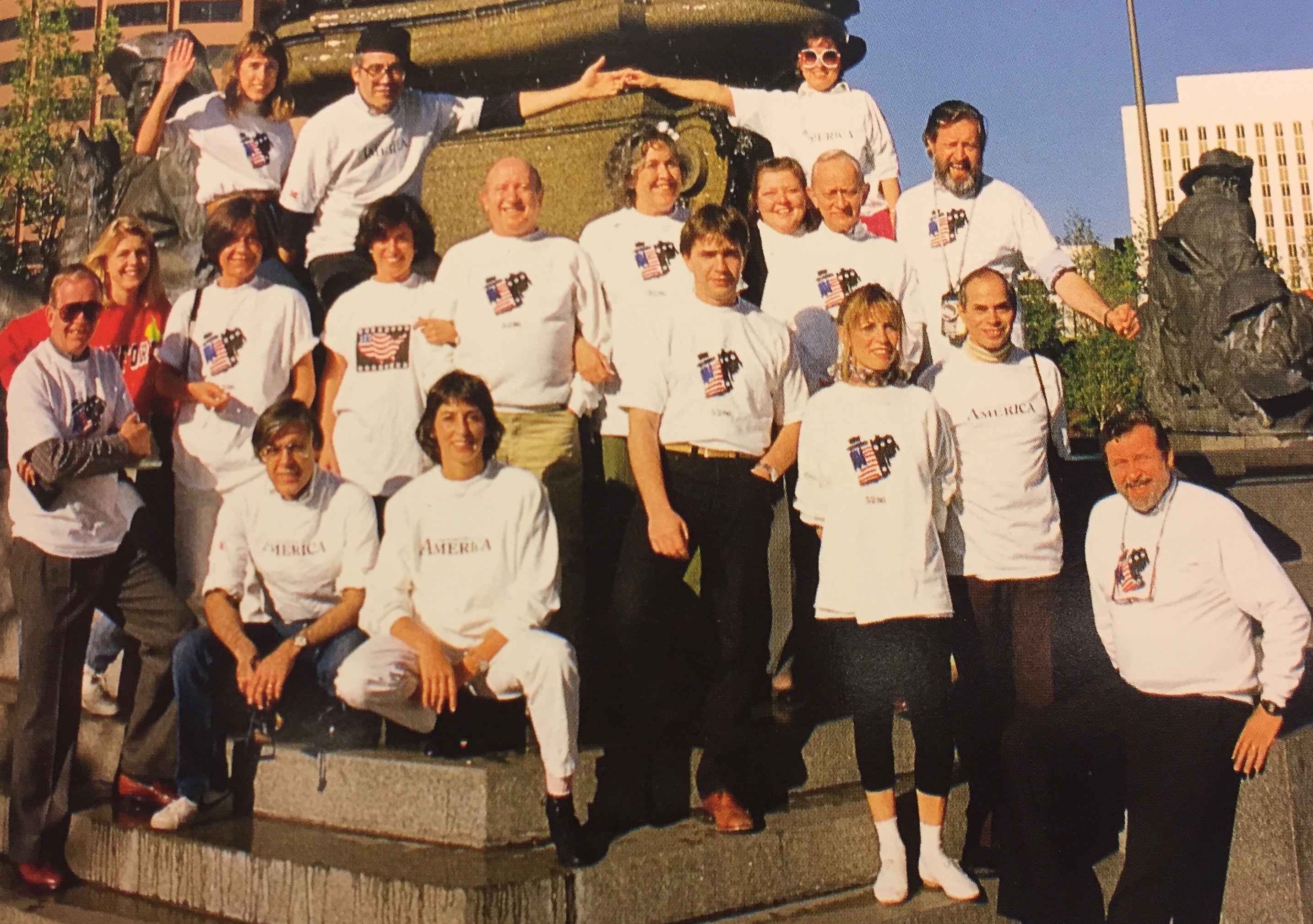
Accomplices: “Day in the Life of America” editors (left-right, top-bottom) Anne Stovell (Time), Robert Pledge (Contact Press Images), Shirley LeGoubin (Colorific), Anna Romer, Claudine Maugendre (Actuel), Susan Vermazen (New York Magazine), Arnold Drakpin (Time), Karen Mullarkey (Newsweek), Sandra Eisert (San José Mercury News), Howard Chapnick (Black Star), Michael Rand (Sunday Times Magazine, Rich Clarkson (National Geographic), Woodfin Camp (Woodfin Camp Associates), Leslie Smolan, Christian Caujolle (Libération), Eliane Laffont (Sygma), Dieter Stiener (Stern), John Durniak. (Photo: Paul Chesley)
•
Among the A-list photographers, many were in the same position as the editors: too old or established to be there, too dumb to understand what was happening. These included White House photographer David Hume Kennerly, Eddie Adams, and David Burnett, the latter co-owner of Contact Press Images (where David Cohen had worked as an editor). Carl Mydans, well into his eighties, was no doubt happy that someone remembered he was still alive, while Lynn Goldsmith and Jay Maisel offered a veneer of accomplishment from celebrity and corporate photography (although in their own deal-making they would never have consented to the dire terms of the Day in the Life of America contract). The most egregious example of pandering was the presence of noted camera buff and former Watergate luminary Senator Howard Baker (R-TN).
 Burk Uzzle and Mary Ellen Mark represented Archive Photo, a short-lived Magnum break-away group. Although the organizers pressed hard for Magnum participation, the project attracted only Steve McCurry, Eli Reed, and Sebastião Salgado, Jr. from the Magnum roster. Smolan’s girlfriend, Jennifer Erwitt, was on the production team and persuaded her father Elliott to join the project. Magnum was otherwise conspicuously absent, despite the persistent efforts of Robert Pledge to draw them in. …
Burk Uzzle and Mary Ellen Mark represented Archive Photo, a short-lived Magnum break-away group. Although the organizers pressed hard for Magnum participation, the project attracted only Steve McCurry, Eli Reed, and Sebastião Salgado, Jr. from the Magnum roster. Smolan’s girlfriend, Jennifer Erwitt, was on the production team and persuaded her father Elliott to join the project. Magnum was otherwise conspicuously absent, despite the persistent efforts of Robert Pledge to draw them in. …
(Part 1 I 2 I 3 I 4 I 5 I 6 I 7)
•
Text copyright © 2018 by Robert Dannin. All rights reserved.
•
(For an index of links to all posts in this series, click here.)
•
Robert Dannin holds a doctorate in linguistics and anthropology from the School for Advanced Studies in the Social Sciences in Paris. He taught at Brown University, New York University, and Suffolk University in Boston. He is co-founder and director of the Ddora Foundation, and serves as a trustee at Mount Ida College in Newton, Mass. Among his scholarly publications, Black Pilgrimage to Islam (Oxford University Press, 2002) was the first ethnography of Islamic religious conversion in America.
In 2009 Dannin was awarded an inaugural residency at the Norman Mailer Writer’s Colony. His most recent work is a biography of Jacob Schiff, the Gilded Age banker and rival to J. P. Morgan.
Dannin paid for his education by working as a cook, translator, ghostwriter, and copywriter/photo editor at Sipa Press in Paris from 1978 to 1981. He was news editor for Sygma New York and later the editorial director of Magnum, where he produced Sebastião Salgado Jr.’s “An Archaeology of the Industrial Age,” eventually published as Workers (Aperture). His other editorial credits include James Nachtwey’s Inferno (Phaidon) and the survey Arms Against Fury: Magnum Photographers in Afghanistan (powerHouse).
Dannin is the author of numerous critical essays about photojournalism. From 1995 to 1997 he served as special consultant on photography to the office of the New York Attorney General. To contact Robert Dannin, click here.


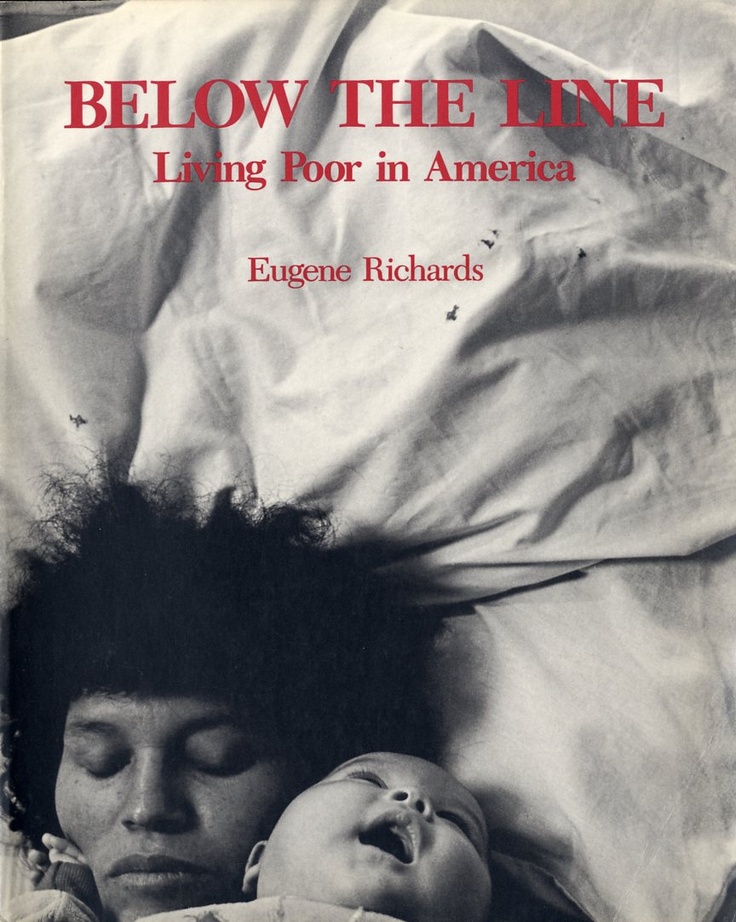
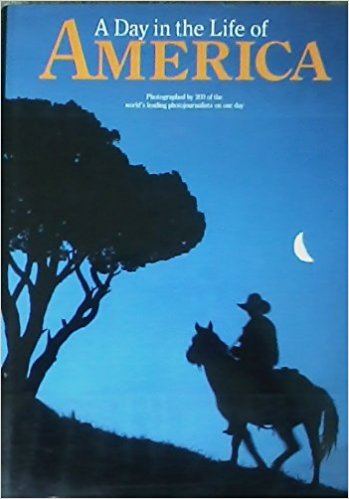

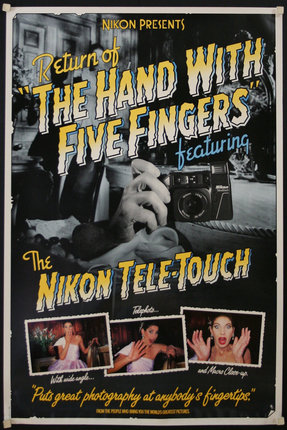

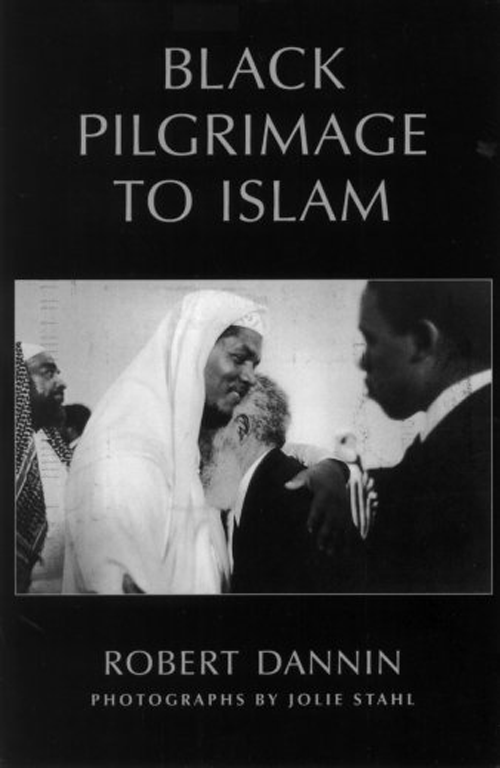




I just found (and read) Parts 1&2 of your series. Thanks for writing this. Back when the Day In The Life Series started, I found myself, as a photographer, being totally against the concept. I didn’t have the background you did to judge and understand it but I felt there was something inherently wrong the process and how it was changing the concept of photojournalism/documentary photography.
Of course back then, it seemed I was the only photographer who felt this way. Every other photographer I knew would do anything to become part of these projects. It is no wonder why we have now devolved into “everyone is a photographer”.